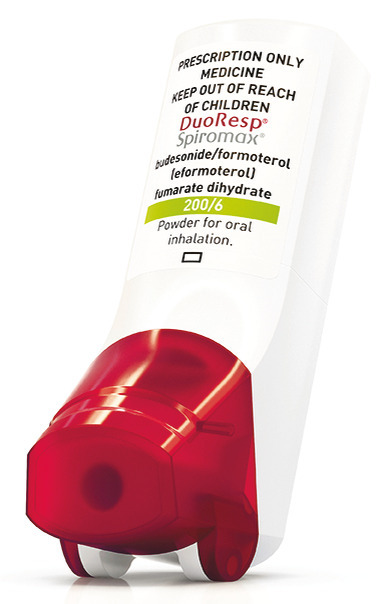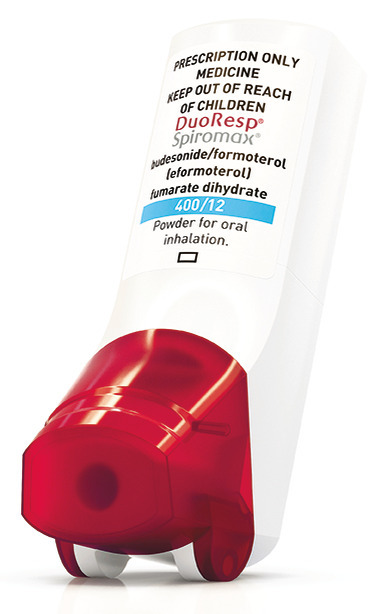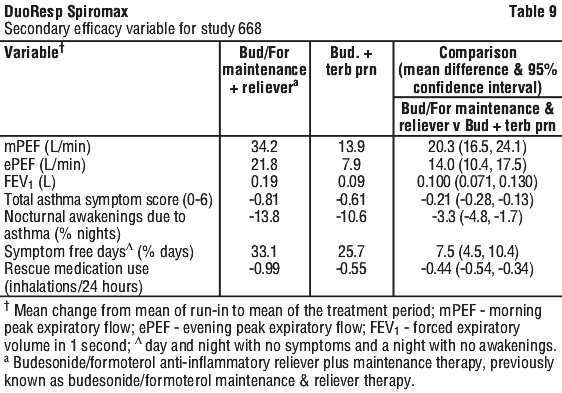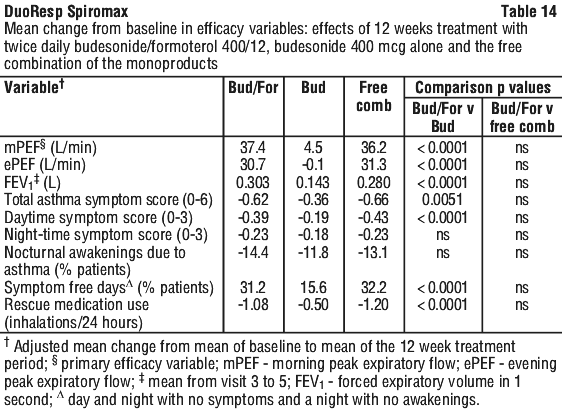SUMMARY CMI
DUORESP® SPIROMAX®
Consumer Medicine Information (CMI) summary
The full CMI on the next page has more details. If you are worried about using this medicine, speak to your doctor or pharmacist.
1. Why am I using DUORESP SPIROMAX?
DUORESP SPIROMAX contains two active ingredients in one inhaler: budesonide and formoterol fumarate dihydrate. It is inhaled into the lungs for the treatment of asthma or Chronic Obstructive Pulmonary Disease (COPD).
For more information, see Section 1. Why am I using DUORESP SPIROMAX? in the full CMI.
2. What should I know before I use DUORESP SPIROMAX?
Do not use if you have ever had an allergic reaction to any medicine containing formoterol or budesonide or any of the ingredients listed at the end of the CMI.
Talk to your doctor if you have any other medical conditions, take any other medicines, or are pregnant or plan to become pregnant or are breastfeeding.
For more information, see Section 2. What should I know before I use DUORESP SPIROMAX? in the full CMI.
3. What if I am taking other medicines?
Some medicines may interfere with DUORESP SPIROMAX and affect how it works. A list of these medicines is in Section 3. What if I am taking other medicines? in the full CMI.
4. How do I use DUORESP SPIROMAX?
- ASTHMA - Anti-inflammatory reliever only (DUORESP SPIROMAX 200/6) - If you get asthma symptoms, take 1 inhalation and wait a few minutes. If you do not feel better, take another inhalation.
- ASTHMA - Anti-inflammatory reliever plus maintenance therapy (DUORESP SPIROMAX 200/6) – See above for reliever instructions. The usual maintenance dose is 2 inhalations per day (given either as 1 inhalation in the morning and evening or as 2 inhalations in either the morning or evening).
- ASTHMA - Daily fixed dose maintenance therapy (DUORESP SPIROMAX 200/6 and 400/12) – DUORESP SPIROMAX 200/6 usual dose is 1-2 inhalations twice a day. DUORESP SPIROMAX 400/12 usual dose is 2 inhalations twice a day.
- COPD - The usual dose is 2 inhalations of DUORESP SPIROMAX 200/6 twice daily or 1 inhalation of DUORESP SPIROMAX 400/12 twice daily.
- Each pack of DUORESP SPIROMAX contains an instruction leaflet that tells you the correct way to use the device
More instructions can be found in Section 4. How do I use DUORESP SPIROMAX? in the full CMI.
5. What should I know while using DUORESP SPIROMAX?
| Things you should do |
|
| Things you should not do |
|
| Driving or using machines |
|
| Looking after your medicine |
|
For more information, see Section 5. What should I know while using DUORESP SPIROMAX? in the full CMI.
6. Are there any side effects?
Common side effects: sore, yellowish, raised patches in the mouth (thrush), fast or irregular heart rate, headache
Serious side effects: fever or chills, increased mucus production, change in mucus colour, increased cough or breathing difficulties
For more information, including what to do if you have any side effects, see Section 6. Are there any side effects? in the full CMI.
FULL CMI
DUORESP® SPIROMAX® Powder for Inhalation
Active ingredient(s): Budesonide and formoterol fumarate dihydrate
Consumer Medicine Information (CMI)
This leaflet provides important information about using DUORESP SPIROMAX. You should also speak to your doctor or pharmacist if you would like further information or if you have any concerns or questions about using DUORESP SPIROMAX.
Where to find information in this leaflet:
1. Why am I using DUORESP SPIROMAX?
2. What should I know before I use DUORESP SPIROMAX?
3. What if I am taking other medicines?
4. How do I use DUORESP SPIROMAX?
5. What should I know while using DUORESP SPIROMAX?
6. Are there any side effects?
7. Product details
1. Why am I using DUORESP SPIROMAX?
DUORESP SPIROMAX contains two active ingredients in one inhaler: budesonide and formoterol fumarate dihydrate (hereafter referred to as formoterol).
- Budesonide belongs to a group of medicines called corticosteroids. Budesonide acts directly on your airways to reduce inflammation.
- Formoterol belongs to a group of medicines called beta-2-agonists. Formoterol opens up the airways to help you breathe more easily.
DUORESP SPIROMAX is inhaled into the lungs for the treatment of asthma or Chronic Obstructive Pulmonary Disease (COPD).
ASTHMA
Asthma is a disease where the airways of the lungs become narrow and inflamed (swollen), making it difficult to breathe. This may for example be due to exercise, or exposure to allergens (e.g. an allergy to house dust mites, smoke or air pollution) or other things that irritate your lungs.
The budesonide in DUORESP SPIROMAX helps to improve your condition and to prevent asthma attacks from occurring.
The formoterol in DUORESP SPIROMAX helps you breathe more easily.
Some people can take DUORESP SPIROMAX when they need it – they use DUORESP SPIROMAX as an anti-inflammatory “reliever” to treat their symptoms when their asthma gets worse and to help prevent asthma attacks, or to help prevent symptoms from happening (e.g. before exercise or exposure to other triggers such as allergens).
Some people need to take DUORESP SPIROMAX every day – they use their DUORESP SPIROMAX as a daily maintenance preventer to help maintain control of their asthma symptoms and help prevent asthma attacks.
CHRONIC OBSTRUCTIVE PULMONARY DISEASE (COPD)
COPD (which includes chronic bronchitis and emphysema) is a long-term lung disease. There is often permanent narrowing and persistent inflammation of the airways.
Symptoms may include difficulty in breathing (breathlessness or wheezing), coughing and increased sputum.
DUORESP SPIROMAX when used as prescribed will help to control your COPD symptoms (i.e. breathing difficulties).
2. What should I know before I use DUORESP SPIROMAX?
Warnings
Do not use DUORESP SPIROMAX if:
- you are allergic to formoterol or budesonide, or any of the ingredients listed at the end of this leaflet.
- Always check the ingredients to make sure you can use this medicine.
Check with your doctor if you:
- have any other medical conditions including: thyroid or adrenal gland problems, diabetes, heart problems liver problems, tuberculosis, low levels of potassium in the blood.
- take any medicines for any other condition.
- currently have an infection, this medicine may hide some of the signs of an infection.
During treatment, you may be at risk of developing certain side effects. It is important you understand these risks and how to monitor for them. See additional information under Section 6. Are there any side effects?
Pregnancy and breastfeeding
Check with your doctor if you are pregnant or intend to become pregnant.
Talk to your doctor if you are breastfeeding or intend to breastfeed.
Children
Do not give this medicine to a child under 18 years of age.
3. What if I am taking other medicines?
Tell your doctor or pharmacist if you are taking any other medicines, including any medicines, vitamins or supplements that you buy without a prescription from your pharmacy, supermarket or health food shop.
Some medicines may interfere with DUORESP SPIROMAX and affect how it works. These include:
- medicines used to treat heart problems or high blood pressure such as beta-blockers, diuretics and antiarrhythmics (disopyramide, procainamide and quinidine)
- medicines used to treat glaucoma such as beta-blockers
- medicines used to treat depression or other mood/mental disorders such as tricyclic antidepressants, monoamine oxidase inhibitors and phenothiazines
- medicines used to treat hayfever, coughs, colds and runny nose such as antihistamines
- medicines used to treat fungal infections (e.g. ketoconazole, itraconazole, voriconazole)
- xanthine derivatives (e.g. theophylline) which are a class of medicines used to treat asthma and COPD
- Medicines like digoxin used to treat heart failure
- Medicines used to treat HIV infection
- Medicines for Parkinson's disease (e.g. L-dopa)
- Medicines for thyroid problems (e.g. levothyroxine)
Check with your doctor or pharmacist if you are not sure about what medicines, vitamins or supplements you are taking and if these affect DUORESP SPIROMAX.
4. How do I use DUORESP SPIROMAX?
How much to use
- Follow the instructions provided and use DUORESP SPIROMAX until your doctor tells you to stop.
ASTHMA (Adults only)
Your doctor should give you a personal Asthma Action Plan to help manage your asthma. This plan will include what medicines to take as a reliever when you have symptoms or sudden attacks of asthma, medicines you take to prevent symptoms from occurring (e.g. prior to exercise or allergen exposure) and if you need to take daily maintenance medicines to help control your asthma.
It is important that you discuss with you doctor both your exposure to triggers and how often you exercise, as these could impact how your doctor prescribes your DUORESP SPIROMAX.
Your doctor may have prescribed DUORESP SPIROMAX for you to use as:
- an anti-inflammatory reliever medicine only,
- both an anti-inflammatory reliever and a daily maintenance preventer medicine or,
- as a daily maintenance preventer only, where another medicine is used as a reliever.
Ask your doctor if you have any questions about how you should be using your DUORESP SPIROMAX. If your asthma has been under control for some time, your doctor may tell you to take less inhalations of DUORESP SPIROMAX, prescribe you a lower strength of DUORESP SPIROMAX or recommend that you use DUORESP SPIROMAX in a different way.
If you are using more inhalations of your reliever medicine or you are wheezing or breathless more than usual tell your doctor as your asthma may be getting worse.
Anti-inflammatory reliever only (DUORESP SPIROMAX 200/6)
DUORESP SPIROMAX 200/6 can be used to treat asthma symptoms when they happen and to help stop asthma symptoms from happening (e.g. just before exercise or before you get exposed to other triggers).
If you get asthma symptoms, take 1 inhalation and wait a few minutes. If you do not feel better, take another inhalation.
Your doctor will tell you how many inhalations to take before exercising or exposure to other triggers to help stop symptoms from happening.
Do not use more than 6 inhalations on a single occasion or more than 12 inhalations in any day. If your symptoms continue to worsen over 3 days, despite using additional inhalations, tell your doctor.
Have your DUORESP SPIROMAX reliever with you at all times.
Anti-inflammatory reliever plus maintenance therapy (DUORESP SPIROMAX 200/6)
DUORESP SPIROMAX 200/6 can be used to treat asthma symptoms when they happen. DUORESP SPIROMAX 200/6 can also be used to help stop asthma symptoms from happening (e.g. just before exercise or before you get exposed to other triggers).
If you get asthma symptoms, take 1 inhalation of DUORESP SPIROMAX 200/6 and wait a few minutes. If you do not feel better, take another inhalation.
Your doctor will tell you how many inhalations of DUORESP SPIROMAX 200/6 to take before exercising or exposure to other triggers to help stop symptoms from happening.
Have your DUORESP SPIROMAX 200/6 reliever with you at all times.
You also need to take your DUORESP SPIROMAX 200/6 daily as your maintenance preventer. The usual maintenance dose is 2 inhalations per day (given either as 1 inhalation in the morning and evening or as 2 inhalations in either the morning or evening). Your doctor may prescribe a maintenance dose of DUORESP SPIROMAX 200/6, 2 inhalations twice a day.
Do not use more than 6 inhalations on a single occasion or more than 12 inhalations of DUORESP SPIROMAX (as needed and daily dose) in any day. If your symptoms continue to worsen over 3 days, despite using additional inhalations, tell your doctor.
NOTE: DUORESP SPIROMAX 400/12 is not recommended to be used as anti-inflammatory reliever medicine.
Daily fixed dose maintenance therapy (DUORESP SPIROMAX 200/6 and 400/12)
DUORESP SPIROMAX 200/6 can be used as a daily fixed-dose maintenance preventer. The usual dose is 1-2 inhalations twice a day.
DUORESP SPIROMAX 400/12 is recommended only for patients who need a higher daily dose.
The usual dose is 2 inhalations twice a day. Your doctor may also tell you to take 1 inhalation twice a day, if your asthma has been under control.
Do not take more than 2 inhalations twice a day of DUORESP SPIROMAX 200/6 or 400/12.
Have your separate reliever with you at all times.
COPD (Adults)
The usual dose (also maximum recommended dose) is:
- 2 inhalations of DUORESP SPIROMAX 200/6 twice daily
or - 1 inhalation of DUORESP SPIROMAX 400/12 twice daily.
Your doctor should tell you the best way to manage your symptoms and any flare ups. This may include additional medicines (such as reliever medicines) to use when you have sudden attacks of breathlessness.
If you are using more inhalations of your reliever medicine or you are wheezing or breathless more than usual tell your doctor.
If your COPD gets worse, your doctor may give you some additional medicines (such as oral corticosteroids or antibiotics).
When to use DUORESP SPIROMAX
- Please refer to instructions above for when DUORESP SPIROMAX should be used.
How to use DUORESP SPIROMAX
- Each pack of DUORESP SPIROMAX contains an instruction leaflet that tells you the correct way to use it. Please read this carefully.
If you forget to use DUORESP SPIROMAX
DUORESP SPIROMAX should be used regularly at the same time each day. If you miss your dose at the usual time, take your dose as soon as you remember.
If it is almost time for your next dose, skip the dose you missed and take your next dose when you are meant to.
Do not take a double dose to make up for the dose you missed.
If you are using DUORESP SPIROMAX as a reliever medicine, consult your doctor on the correct use of the product.
If you use too much DUORESP SPIROMAX
If you think that you have used too much DUORESP SPIROMAX, you may need urgent medical attention.
You should immediately:
- phone the Poisons Information Centre
(by calling 13 11 26), or - contact your doctor, or
- go to the Emergency Department at your nearest hospital.
You should do this even if there are no signs of discomfort or poisoning.
5. What should I know while using DUORESP SPIROMAX?
Things you should do
If you have an Asthma Action Plan that you have agreed with your doctor, follow it closely at all times.
Keep using DUORESP SPIROMAX for as long as your doctor tells you to, even if you are feeling well.
See your doctor regularly to make sure that your asthma or COPD is not getting worse.
Have your reliever medicine available at all times. As advised by your doctor, this may be your DUORESP SPIROMAX (200/6) or another reliever medication.
Rinse your mouth out with water after taking your daily morning and/or evening dose of DUORESP SPIROMAX and spit this out. If you don't rinse your mouth you are more likely to develop thrush in your mouth. You do not have to rinse your mouth if you have to take occasional doses of DUORESP SPIROMAX for relief of asthma symptoms (i.e. as an anti-inflammatory reliever).
If you become pregnant while using DUORESP SPIROMAX, tell your doctor.
Tell your doctor if you notice any issues with your eyes such as blurred vision or other problems with your eyesight. Your doctor may need to send you to an ophthalmologist (eye doctor) to check that you don't have eye problems such as cataracts (clouding on the eye lens), glaucoma (increased pressure in your eyeballs) or other rare eye conditions reported with corticosteroid use.
Corticosteroids taken into the lungs for long periods (e.g. 12 months) may affect growth. In rare cases, some patients may be sensitive to the growth effects of corticosteroids, so the doctor may monitor a patient's height.
Call your doctor straight away if you:
- notice any signs of pneumonia (infection of the lung). Signs include fever or chills, increased mucus production or change in mucus colour, increased cough or increased breathing difficulties. Pneumonia is a serious medical condition and will require urgent medical attention.
Remind any doctor, dentist or pharmacist you visit that you are using DUORESP SPIROMAX.
Things you should not do
- Do not stop using this medicine suddenly.
- Do not take any other medicines for your asthma or COPD without checking with your doctor.
Driving or using machines
Be careful before you drive or use any machines or tools until you know how DUORESP SPIROMAX affects you.
DUORESP SPIROMAX may cause dizziness, blurred vision, light-headedness, tiredness or drowsiness in some people when they first start using it.
Looking after your medicine
- Keep your SPIROMAX device dry and clean. If necessary, you may wipe the mouthpiece of your SPIROMAX device after use with a dry cloth or tissue.
- Keep your SPIROMAX in a cool dry place where the temperature stays below 25°C, with the cover firmly in place.
Follow the instructions in the carton on how to take care of your medicine properly.
Store it in a cool dry place away from moisture, heat or sunlight; for example, do not store it:
- in the bathroom or near a sink, or
- in the car or on window sills.
Keep it where young children cannot reach it.
When to discard your medicine
Since some medicine may remain inside your DUORESP SPIROMAX you should always return it to your pharmacist for disposal including:
- when you have taken all your doses and the dose indicator is on zero ('0' - see instructions in the pack), or
- if it is damaged or past its expiry date, or
- if it has been removed from the foil wrapping for greater than 12 months, or
- if your doctor/pharmacist has told you to stop using it.
Getting rid of any unwanted medicine
If you no longer need to use this medicine or it is out of date, take it to any pharmacy for safe disposal.
Do not use this medicine after the expiry date.
6. Are there any side effects?
All medicines can have side effects. If you do experience any side effects, most of them are minor and temporary. However, some side effects may need medical attention.
See the information below and, if you need to, ask your doctor or pharmacist if you have any further questions about side effects.
Less serious side effects
| Less serious side effects | What to do |
Oral related:
| Oral side effects are less likely to happen if you rinse your mouth out after every time you use your usual morning and/or evening dose of DUORESP SPIROMAX Speak to your doctor if you have any of these less serious side effects and they worry you. |
Serious side effects
| Serious side effects | What to do |
Symptoms of a lung infection (pneumonia):
| Call your doctor straight away, or go straight to the Emergency Department at your nearest hospital if you notice any of these serious side effects. |
Tell your doctor or pharmacist if you notice anything else that may be making you feel unwell.
Other side effects not listed here may occur in some people.
Reporting side effects
After you have received medical advice for any side effects you experience, you can report side effects to the Therapeutic Goods Administration www.tga.gov.au/reporting-problems
By reporting side effects, you can help provide more information on the safety of this medicine.
Always make sure you speak to your doctor or pharmacist before you decide to stop taking any of your medicines.
7. Product details
This medicine is only available with a doctor's prescription.
What DUORESP SPIROMAX contains
| Active ingredient (main ingredient) | budesonide and formoterol fumarate dihydrate |
| Other ingredients (inactive ingredients) | lactose monohydrate (which may contain milk protein residue) |
| Potential allergens | lactose |
Do not take this medicine if you are allergic to any of these ingredients.
The amount of lactose contained in DUORESP SPIROMAX is very small and does not normally cause problems in lactose intolerant people.
DUORESP SPIROMAX does not contain sucrose, gluten, tartrazine or any other azo dyes.
What DUORESP SPIROMAX looks like
DUORESP SPIROMAX is a plastic inhaler containing the medicine as a dry powder. The SPIROMAX device is white in colour, with a semi-transparent wine red mouthpiece cover at the bottom.
DUORESP SPIROMAX 200/6 is registered in packs of 1, 2 or 3 inhalers. Each DUORESP SPIROMAX 200/6 inhaler contains 120 inhalations. (Aust R 267385).
DUORESP SPIROMAX 400/12 is registered in packs of 1, 2 or 3 inhalers. Each DUORESP SPIROMAX 400/12 inhaler contains 60 inhalations. (Aust R 267386).
Not all pack sizes may be marketed.
Who distributes DUORESP SPIROMAX
Teva Pharma Australia Pty Ltd
Level 1, 37 Epping Road
Macquarie Park NSW 2113
This leaflet was prepared in May 2025.
® DUORESP and SPIROMAX are registered trademarks of the Teva group of companies.
Published by MIMS July 2025




 As with other inhalation therapy, paradoxical bronchospasm may occur in very rare cases.
As with other inhalation therapy, paradoxical bronchospasm may occur in very rare cases. In these placebo-controlled studies, the incidence of pneumonia was low, with no consistent evidence of increased risk of pneumonia for budesonide + formoterol treated patients compared to patients on placebo.
In these placebo-controlled studies, the incidence of pneumonia was low, with no consistent evidence of increased risk of pneumonia for budesonide + formoterol treated patients compared to patients on placebo. Analysis of time to first severe exacerbation in SYGMA 1 showed that the likelihood of experiencing a severe exacerbation was statistically significantly higher for SABA as needed use compared to budesonide/formoterol anti-inflammatory reliever therapy over the 1 year treatment period, with a risk reduction of 56% (Hazard Ratio (HR): 0.44 (0.33, 0.58); p < 0.001). There were no differences in the probability of experiencing a severe exacerbation between budesonide/formoterol anti-inflammatory reliever therapy and a maintenance dose of budesonide given with SABA as needed.
Analysis of time to first severe exacerbation in SYGMA 1 showed that the likelihood of experiencing a severe exacerbation was statistically significantly higher for SABA as needed use compared to budesonide/formoterol anti-inflammatory reliever therapy over the 1 year treatment period, with a risk reduction of 56% (Hazard Ratio (HR): 0.44 (0.33, 0.58); p < 0.001). There were no differences in the probability of experiencing a severe exacerbation between budesonide/formoterol anti-inflammatory reliever therapy and a maintenance dose of budesonide given with SABA as needed.

 The study specifically demonstrates that both the budesonide and the formoterol components of budesonide/formoterol contribute to improved asthma control achieved through the as-needed dosing of budesonide/formoterol within the budesonide/formoterol anti-inflammatory reliever plus maintenance therapy concept.
The study specifically demonstrates that both the budesonide and the formoterol components of budesonide/formoterol contribute to improved asthma control achieved through the as-needed dosing of budesonide/formoterol within the budesonide/formoterol anti-inflammatory reliever plus maintenance therapy concept.


 This study showed that budesonide/formoterol anti-inflammatory reliever plus maintenance therapy treatment is more effective than adjustable therapy with fluticasone/salmeterol plus salbutamol in controlling asthma in adults and adolescents.
This study showed that budesonide/formoterol anti-inflammatory reliever plus maintenance therapy treatment is more effective than adjustable therapy with fluticasone/salmeterol plus salbutamol in controlling asthma in adults and adolescents. When administered twice daily, budesonide/formoterol 200/6 is a more effective treatment than budesonide, at corresponding budesonide doses.
When administered twice daily, budesonide/formoterol 200/6 is a more effective treatment than budesonide, at corresponding budesonide doses. In conclusion, there was a greater improvement in lung function and asthma control with budesonide/formoterol 100/6 than with a doubled dose of budesonide.
In conclusion, there was a greater improvement in lung function and asthma control with budesonide/formoterol 100/6 than with a doubled dose of budesonide. When administered twice daily, budesonide/formoterol 400/12 is a more effective treatment for the majority of clinical endpoints than the corresponding budesonide dose.
When administered twice daily, budesonide/formoterol 400/12 is a more effective treatment for the majority of clinical endpoints than the corresponding budesonide dose.

